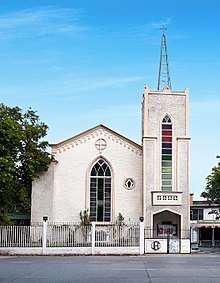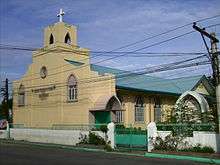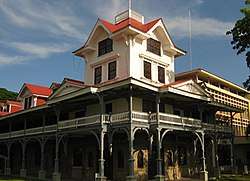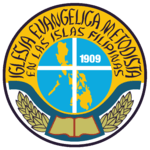Protestantism in the Philippines
Protestant denominations arrived in the Philippines in 1898, after the United States took control of the Philippines from Spain, first with the United States Army as chaplains and then within months the denominations sent missionaries.
| Christianity by country |
|---|
 |
|
|
|
|
Oceania
|
|
South America
|
|
|
Protestants makes up nearly 11% of the Filipino population.[1] They include a wide variety of Pentecostal, Evangelical and independent churches. Some denominations were founded locally by indigenous people.
Statistics
History
It is likely that there was some Protestant activity in the Philippines before 1898, such as during the British occupation of the Philippines, but there was no churches or missions established.
Protestantism began to develop in the Philippines after the Spanish–American War when the United States acquired the Philippines from the Spanish with the 1898 Treaty of Paris.[3] During American Colonial Period, the Catholic Church was disestablished as the state religion, giving Protestant missionaries more opportunities to enter the islands. In addition, there was a backlash against the Hispanic Catholicism and a greater acceptance of Protestantism represented by the Americans.[4] The dominance of the Catholic Church in all aspects of life in Spanish Philippines and Protestant anti-Catholic animosity were prominent reasons for the start of Protestant missionary activity.[5] In 1901 the Evangelical Union was established in the Philippines to co-ordinate activities amongst the Protestant denominations and lay the foundations for an indigenous religious movement.[6]
The first Protestant service during this era was on Sunday, August 28, 1898.[lower-alpha 1] Chaplain George Stull, a member of The Methodist Episcopal Church, came with the occupying forces. Although his primary duty was to minister to the soldiers, he recorded in his diary that that first service, held in an old Spanish dungeon facing Manila Bay, was attended not only by his own men but by some Filipinos as well. He commented on this service:[7]
"That the power of God will use this day to make a good Catholic better, any weak American stronger, any backslider ashamed, and the gloomy old dungeon the beginning of wonderful things in these Islands, is my prayer."[8]
The Comity Agreement (1898–1941)


After the defeat of the Spanish in the Battle of Manila Bay by the U.S. Navy's Asiatic Squadron, Presbyterian, Baptist and Methodist leaders met in 1898 in New York to discuss how to bring Protestantism to the Philippines. The result was a comity agreement that divided the Philippines into missionary areas by denomination to avoid future conflicts among themselves and their converts.[9] Only one Protestant denomination would be in each area.
The meeting was followed by another gathering in 1901 by the early missionaries in Manila to further discuss the comity agreement with three specific major agenda items:
- "to organize the Evangelical Union,"
- "choose a common name for Protestant churches," and
- "delineate the geographical work allotments for each church."[10]
From 1898 to 1930 the different Protestant denominations that joined the comity agreement were:
- Methodists (1898) assigned most of lowland Luzon and north of Manila;
- Presbyterians (1899) assigned Bicol, Southern Tagalog area and some parts of Central and Western Visayas;
- Baptists (1900) Western Visayas;
- United Brethren (1901) Mountain Province and La Union;
- Disciples of Christ (1901) Ilocos, Abra, and Tagalog towns;
- Congregationalists (1902), Mindanao except for the western end; and
- Christian and Missionary Alliance (1902), Western Mindanao and Sulu Archipelago.
- Brethren (Kapatirang Kristiano) linked to Plymouth Brethren, was established in the 1930s in San Juan, Metro Manila by a missionary named Cyril H. Brooks. They planted numerous chapels in the Philippines with majority in Bulacan, Pampanga and Rizal Province.
Manila was open to all denominations and mission agencies.[11] The Seventh-day Adventist Church and the Episcopal Church in the Philippines did not join because they wanted to go to all parts of the archipelago.[12] American Protestant Missions (APM) emphasized institutional ministry and medical missions in their evangelistic and missions endeavors.
For a short time the comity agreement worked well, until the situation grew more intricate and splits occurred. The Methodists split in 1909 when Nicolas Zamora founded the Iglesia Evangelica Metodista en las Islas Filipinas (IEMELIF). This shattered the agreement. Thus, the IEMELIF became the first indigenous evangelical denomination, an all-Filipino-supported church at that time, with Methodist Ilocanos from Northern Luzon moved into the areas of the United Church of Christ in the Philippines in Mindanao. Baptist Ilonggos migrated from Iloilo to Central Cotabato, traditionally Christian and Missionary Alliance territory. As this kind of movement increased, the sharp boundaries between the different comity areas became obscured.[13]
Divisions came with growth and expansion, and personality clashes, racial tensions, the dynamics of nationalism, cultural differences, power struggles and other non-theological factors contributed to the schisms. In the 1920s the fundamentalist-modernist controversy in the United States affected the Philippines, causing further division. By 1921, some nineteen independent denominations were registered with the Security and Exchange Commission (SEC) and important splits occurred among the Methodists, Baptists, Presbyterians and Disciples of Christ. Several small denominations, some of them entirely under national leadership, emerged.[14]
Unity of the churches was still a goal. In 1929, the United Brethren, Presbyterian and Congregational Churches formed the United Evangelical Church in the Philippines. In 1932, six of the smaller indigenous denominations of Presbyterian and Methodist backgrounds formed the Iglesia Evangelica Unida de Cristo, or now more commonly known as the Unida Christian Church. The assembly of these indigenous denominations was called by Don Toribio Teodoro, owner of the Ang Tibay shoes. The National Christian Council was founded in 1929 as a successor of the Evangelical Union. This was followed in 1938 by the organization of the Philippine Federation of Evangelical Churches. With the coming of World War II and the Japanese occupation of the Philippines, the United Evangelical Church underwent severe trying circumstances when the mission agencies were completely cut off from the United States. American missionaries were incarcerated and mission funds were unexpectedly discontinued.
World War II and independence
To deal with the diverse Protestant groups, the Japanese during their occupation of the Philippines during Second World War pressed for the formation of the Evangelical Church of the Philippines which combined thirteen denominations. However, most of the larger denominations such as Methodist, Episcopal, Unida and other independent churches refused to join. After the war, the Evangelical Church of the Philippines further fragmented, but the Disciples of Christ, the United Brethren, the Iglesia Evangelica Unida de Cristo, the Evangelica Nacional, some individual congregations of the IEMELIF, the Philippine Methodist and the Presbyterian Churches remained intact. Several churches united to form the United Church of Christ in the Philippines in 1948. In 1949 the United Evangelical Church, the Philippine Federation of Evangelical Churches, and the Iglesia Evangelica Unida de Cristo formed the Philippine Federation of Christian Churches, now called the National Council of Churches in the Philippines. Today, Protestant and evangelical churches and denominations are grouped into major councils of churches: The National Council of Churches in the Philippines (NCCP) for mainline Protestant churches and the Philippine Council of Evangelical Churches (PCEC) for evangelical churches, organized in 1964.
Several independent church organizations emerged in the 1970s and mid-1980s, such as the Jesus Is Lord Church Worldwide, the Greenhills Christian Fellowship founded in 1978 by the Conservative Baptists, the Bread of Life Ministries International founded in 1982, and the Christ's Commission Fellowship and Victory Christian Fellowship both established in 1984. These churches used mass media to spread evangelical Christianity in the country and to establish more non-denominational, Pentecostal, and charismatic churches. These churches grew up rapidly and are considered one of the major Protestant megachurches in the Philippines.[15]
A major factor in the development of Philippine Protestantism is the explicit expression of religious freedom found in Section 5, Article III ("Bill of Rights) of the 1987 Constitution, separating church and state. The concept and its English phrasing has been present in every national charter since the 1935 Constitution promulgated by the Commonwealth government.[16] The Philippine Youth Movement founded in 1926 boosted the move to develop the indigenous Protestant church nationwide.[17]
A theme in the development of Protestantism in the Philippines is the tension between the religion and nationalism. After an initial period of resentment toward American missionaries, Filipinos gradually accepted Protestantism.[18] During the 1920s and '30s, American Methodist missionaries openly supported Filipino independence from the United States.[19]
Education

Protestant missionaries founded many schools and universities in the Philippines. Some of which are founded by early American Protestant missionaries.[20] Most notable of these is Silliman University, the first Protestant school in the country and the first university founded by Americans in Asia. Silliman is followed by the Central Philippine University, its sister institution, and other institutions of higher learning such as Trinity University of Asia, West Negros University, Filamer Christian University, the Philippine Christian University and the Adventist University of the Philippines.
| Institution | Founded | Founding affiliation | Founded (Nationality) | Description |
|---|---|---|---|---|
| Silliman University | 1901 as Silliman Bible School | Presbyterian | American | First American and Protestant founded school and university in Asia and in the Philippines. |
| Central Philippine University | 1905 as Jaro Industrial School | Baptist | American | First Baptist founded and second American university in Asia and in the Philippines. |
| Filamer Christian University | 1904 as Capiz Home School | Baptist | American | |
| Adventist University of the Philippines | 1917 as Philippine Seventh-day Adventist Academy | Seventh-day Adventist Church | Filipino/American | |
| Philippine Christian University | 1946 as Manila Union University | Methodist (United Methodist Church) | American | |
| Wesleyan University-Philippines | 1946 as Philippine Wesleyan College | Methodist (United Methodist Church) | Filipino | |
| West Negros University | 1948 as West Negros College | Baptist (now acquired by the STI Education Systems Holdings Inc.) | Filipino | |
| Trinity University of Asia | 1963 as Trinity College of Quezon City | Episcopalian | American | |
List of major denominations and prominent independent churches
| Emblem | Name | Orientation | Foundation | Leadership | Headquarters | Membership | References | |
|---|---|---|---|---|---|---|---|---|
| Alliance of Bible Christian Churches of the Philippines | ||||||||
| Assemblies of God | Pentecostal | 1940 | Malinta, Valenzuela | 360,000 | ||||
| Baptist Bible Fellowship International | Fundamentalist Baptist | |||||||
| Bread of Life Ministries International | Evangelical | 1982 | Rev. Noel Tan | Crossroad Center, Paligsahan, Quezon City | 35,000 | |||
| Cathedral of Praise | Full Gospel | 1954 | Dr. David E. Sumrall | COP Main Campus, Ermita, Manila | ||||
| Christian and Missionary Alliance Churches of the Philippines | 1901 | |||||||
| Christian Church (Disciples of Christ) | ||||||||
| Christian Reformed Church in the Philippines | Calvinist | 1962 | ||||||
| Christ's Commission Fellowship | Non-Denominational | 1984 | Dr. Peter Fu Tan-Chi | CCF Center, Pasig | 60,000 | |||
| Conservative Baptist Association | ||||||||
| Convention of Philippine Baptist Churches | Mainline Baptist | 1900 | Rev. Jerson Narciso | 500,000 | ||||
| Episcopal Church in the Philippines | Anglican | 1898 | Cathedral Heights, Quezon City | 125,000 | ||||
| Church of the Foursquare Gospel in the Philippines | 1929 | 95,000 | ||||||
 |
Iglesia Evangelica Metodista En Las Islas Filipinas (IEMELIF) | Methodist | 1909 | Rev. Noel M. Abiog | ||||
| Iglesia Evangelica Unida de Cristo (Unida Christian Church) | Evangelical | 1932 | Rev. Richard Buenaventura | 25,000 | ||||
| Philippine Independent Church (Aglipayan Church) | Chalcedonian | 1902 | 917,000 | [21] | ||||
| Jesus Is Lord Church Worldwide (JILCW) | Full Gospel | 1978 | Eddie Villanueva | Manila, Philippines | 5,000,000 (Worldwide) | |||
| Lutheran Church in the Philippines | Lutheran | |||||||
| Philippines Central Conference (United Methodist Church) | Methodist | 200,000-1 million | ||||||
| Presbyterian Church of the Philippines | Presbyterian | 1987 | Rev. Danilo Yandan | Pasig | 11,000 | |||
| Seventh-day Adventist Church | Biblical Christianity | 1863 (US)
1905 (PH) |
Election every 5 years in 3 Unions (North, Central, South) | Luzon, Pasay City
Visayas, Cebu City Mindanao, Cagayan De Oro City |
> 1.1 million | 26 | ||
| Southern Baptist Convention | Baptist | |||||||
| The Salvation Army | Holiness Movement | |||||||
| United Church of Christ in the Philippines | Mainline Methodist/Calvinist | 1901 | West Triangle, Quezon City | 1.5 million | ||||
| Victory | Evangelical | 1984 | Manny Carlos | Every Nation Building, Bonifacio Global City, Taguig | 110,000 | |||
| Word of Hope | Word of Hope Christian Family Church, Veterans Village, Project 7, Quezon City | 50,000 |
Some are members of the Association of Pastors for Outreach and Intercession, G12 Philippines, National Council of Churches in the Philippines, Philippine Council of Evangelical Churches, Philippines for Jesus Movement, Christian Conference of Asia, World Methodist Council and the World Council of Churches.
See also
| Wikimedia Commons has media related to Protestantism in the Philippines. |
Notes
- It was likely that there were Protestant services held in the Philippines during the British Occupation of Manila in the 1760s, at least for soldiers like this 1898 service.
Footnotes
- "Protestant Christianity in the Philippines". Religious Literacy Project. Harvard Divinity School. Retrieved May 8, 2018.
- "Philippines Population Surpassed 100 million people". Philippine Statistics Authority. Retrieved May 8, 2018.
- Deats, 1967, p. 91
- Deats, 1967, p. 92
- Anderson, 1969, p. 298
- Deats, 1967, p. 95
- The Story of Methodism in the Philippines - EARLY BEGINNINGS Archived 2009-02-10 at the Wayback Machine
- Homer Stuntz, 1940, pp. 415-416
- Guillermo & Verora, pp. 1–3
- Guillermo & Verora, p. 3.
- Tuggy & Toliver, p. 19
- James H. Montgomery and Donald A. McGavran, pp. 41–51
- Tuggy & Oliver, pp. 136–40.
- Frank Laubach, p. 23
- McGrath, Alister E. (2008) Christianity's Dangerous Idea: The Protestant Revolution: A History from the Sixteenth Century to the Twenty-First London: Regnum Books (p 454 to 455)
- Elwood, 1969, p. 370
- Anderson, 1969, p. 296
- Deats, 1967, p. 132
- Deats, 1967, p. 142
- Philippines - Religion Archived 2013-12-24 at the Wayback Machine Asian Studies Center, Michigan State University, Retrieved 12-22-13.
- "Table 1.10; Household Population by Religious Affiliation and by Sex; 2010" (PDF). 2015 Philippine Statistical Yearbook. East Avenue, Diliman, Quezon City, Philippines: Philippine Statistics Authority: 1–30. October 2015. ISSN 0118-1564. Retrieved 4 February 2017.
References
- Deats, R., Nationalism and Christianity in the Philippines (Dallas, 1967)
- Anderson, G. H., ‘Providence and Politics behind Protestant Missionary Beginnings in the Philippines’, in G. Anderson (ed.), Studies in Philippine Church History (London, 1969)
- Merlyn L. Guillermo and L. P. Verora, Protestant Churches and Missions in the Philippines, vol. 1 (Valenzuela, Metro Manila: Agape Printing Services, 1982)
- A. Leonard Tuggy and Ralph Toliver, Seeing the Church in the Philippines (Manila: OMF, 1972), pp. 26–53 discussed the Spanish–American War.
- International Baptist Mission for Asians Philippines, http://www.ibmasians.org
- James H. Montgomery and Donald A. McGavran, The Discipling of a Nation (Manila: Global Church Growth Bulletin, 1980)
- Frank Laubach, People of the Philippines (New York: George H. Dora, 1925), p. 23.
- Homer Stuntz (1904). The Philippines and the Far East. Jennings and Pye.
- Elwood, D. J., ‘Varieties of Christianity in the Philippines’, in G. Anderson (ed.), Studies in Philippine Church History (London, 1969)
- Missionary to the Philippines for Wycliffe Bible Translators
.png)